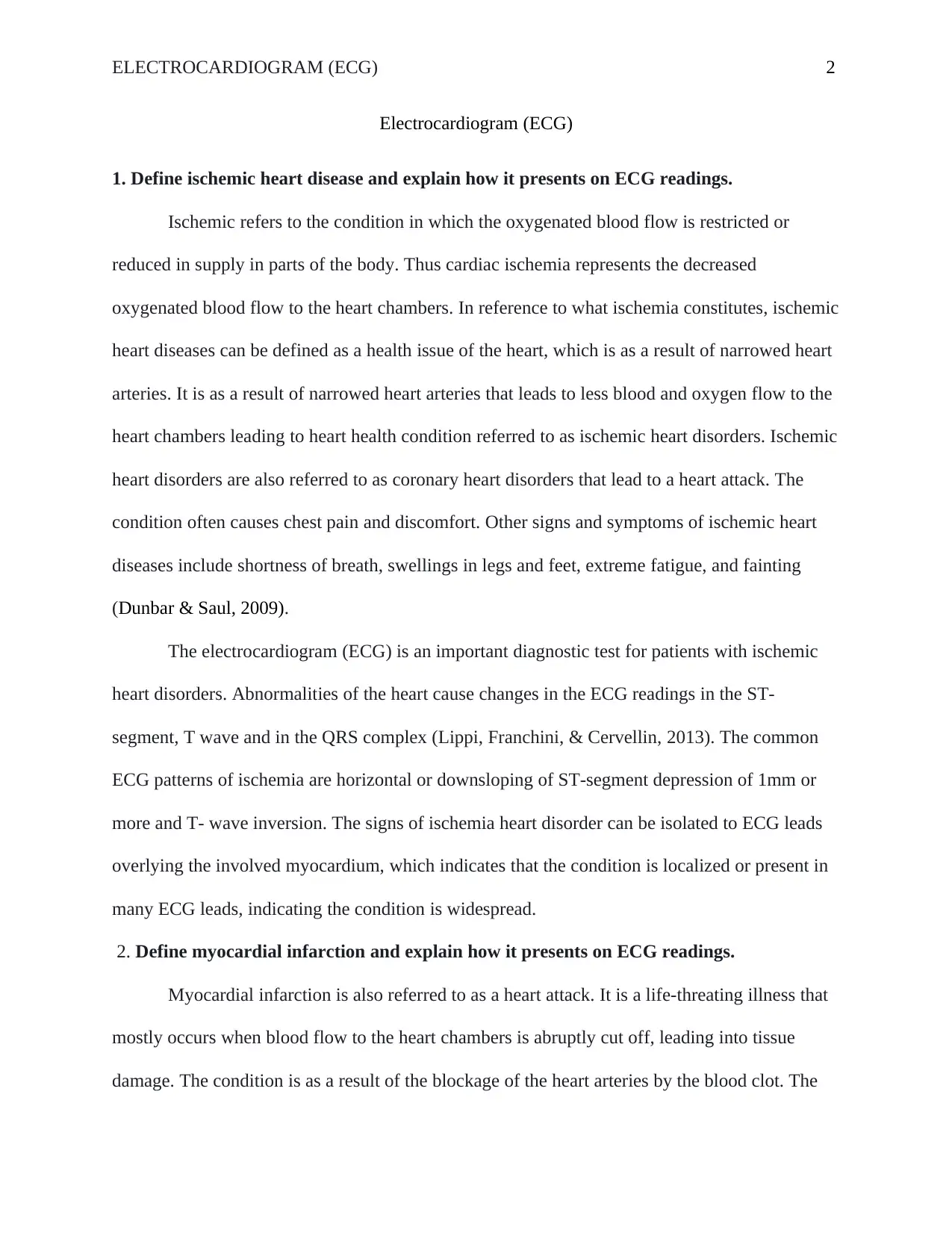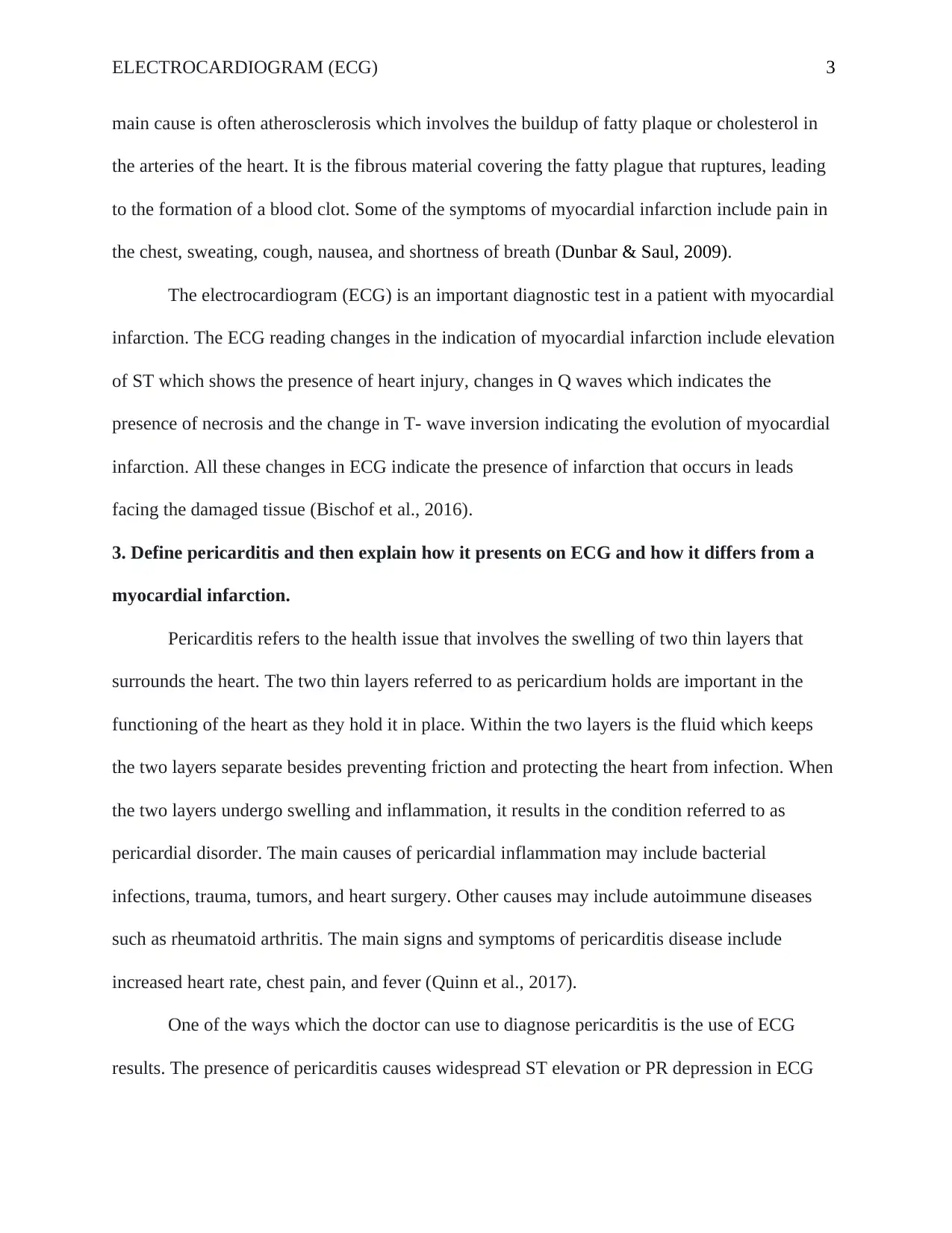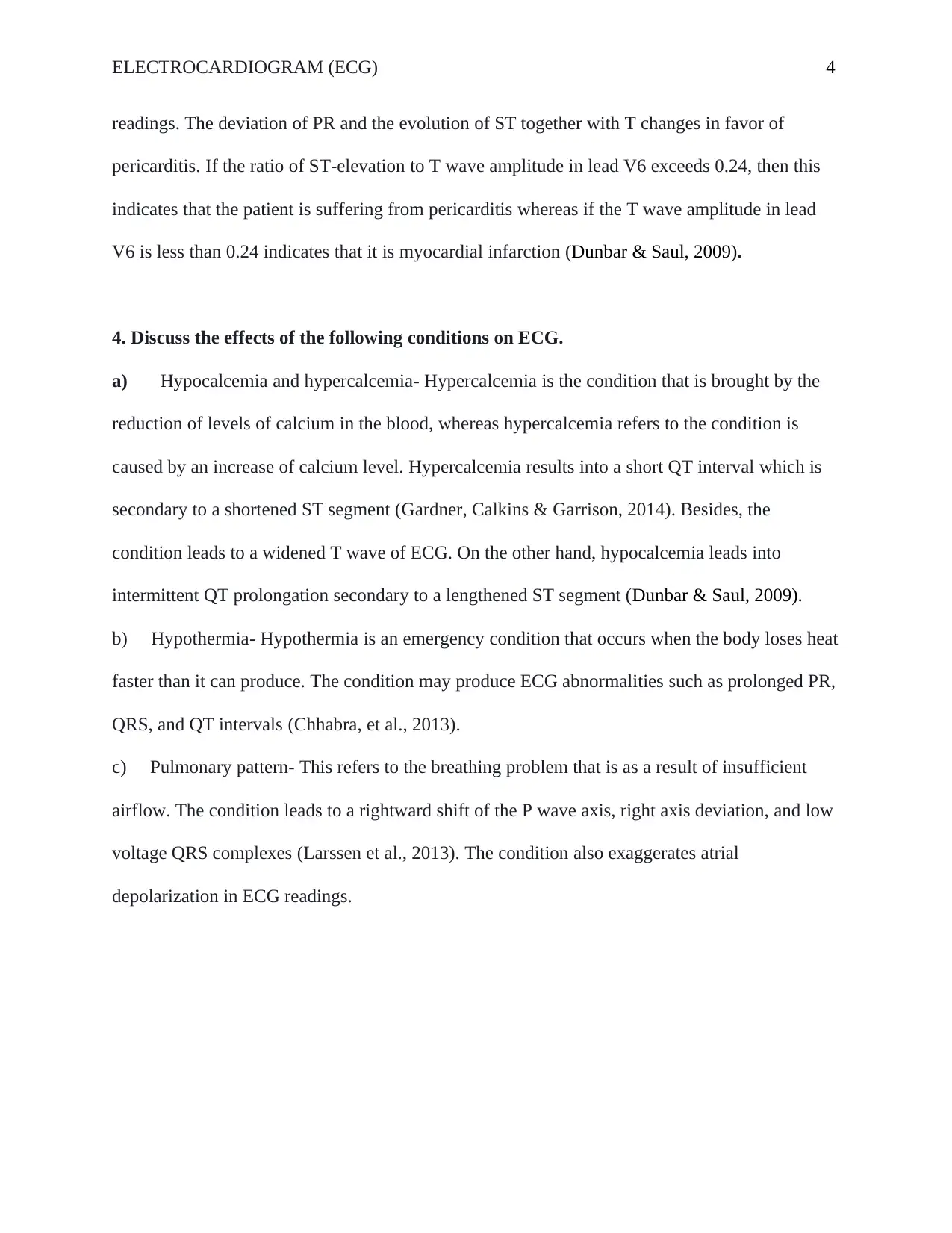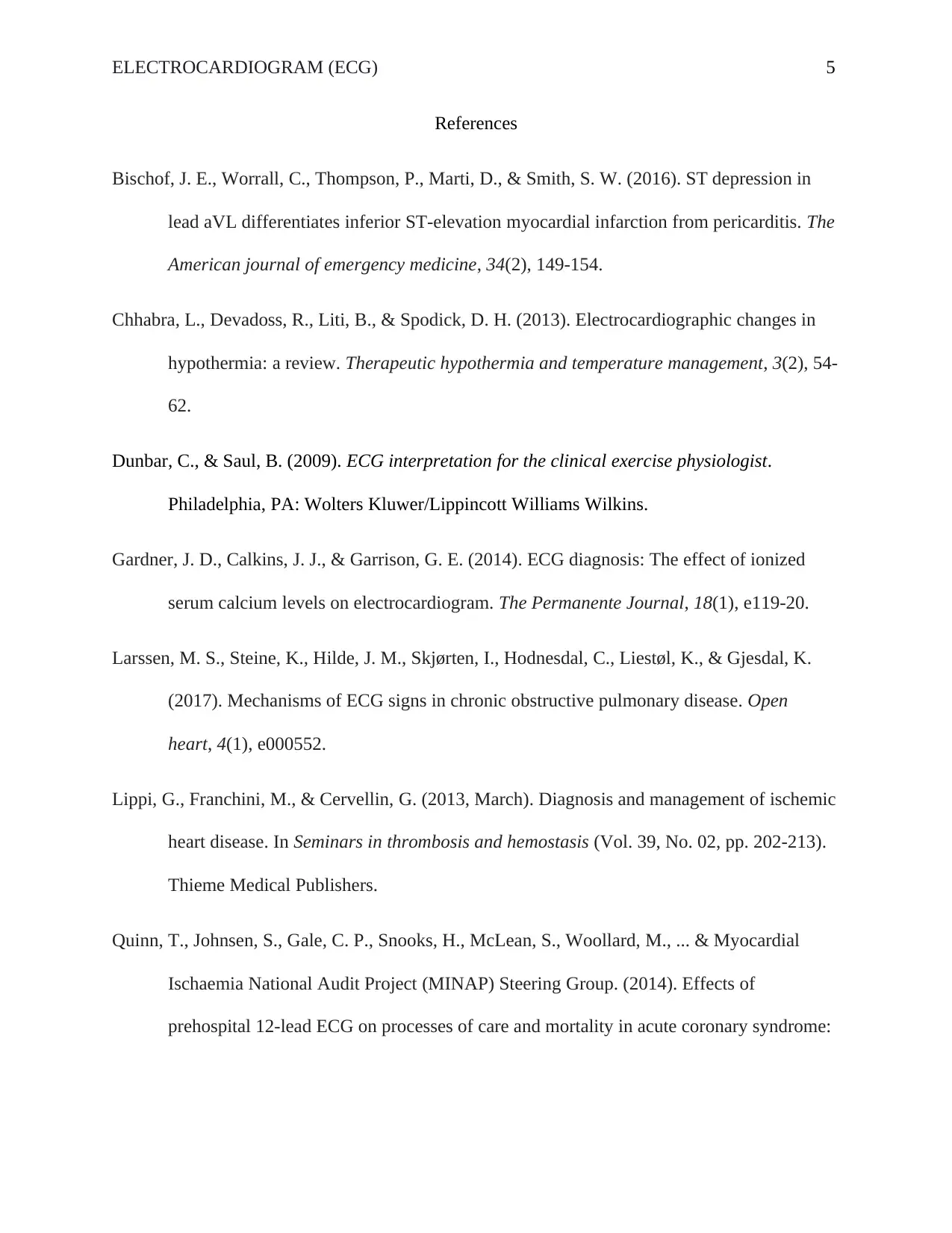EXSC 610: Electrocardiogram (ECG) Analysis of Cardiac Diseases
VerifiedAdded on 2022/10/02
|6
|1382
|134
Essay
AI Summary
This essay delves into the analysis of electrocardiograms (ECGs) in the context of various cardiac conditions. It begins by defining ischemic heart disease and detailing its presentation on ECG readings, focusing on ST-segment depression and T-wave inversion. The essay then defines myocardial infarction (heart attack), explaining the ECG changes associated with it, including ST elevation, Q-wave changes, and T-wave inversion. Furthermore, it defines pericarditis, outlining its ECG characteristics, such as widespread ST elevation or PR depression, and differentiating it from myocardial infarction. The essay also discusses the effects of hypocalcemia, hypercalcemia, hypothermia, and pulmonary patterns on ECG readings, providing a comprehensive overview of ECG interpretation in diverse clinical scenarios, supported by references to scholarly sources and the course textbook.

Running head: ELECTROCARDIOGRAM (ECG) 1
Electrocardiogram (ECG)
Name of Author
Institution of Affiliation
Date of Submission
Electrocardiogram (ECG)
Name of Author
Institution of Affiliation
Date of Submission
Paraphrase This Document
Need a fresh take? Get an instant paraphrase of this document with our AI Paraphraser

ELECTROCARDIOGRAM (ECG) 2
Electrocardiogram (ECG)
1. Define ischemic heart disease and explain how it presents on ECG readings.
Ischemic refers to the condition in which the oxygenated blood flow is restricted or
reduced in supply in parts of the body. Thus cardiac ischemia represents the decreased
oxygenated blood flow to the heart chambers. In reference to what ischemia constitutes, ischemic
heart diseases can be defined as a health issue of the heart, which is as a result of narrowed heart
arteries. It is as a result of narrowed heart arteries that leads to less blood and oxygen flow to the
heart chambers leading to heart health condition referred to as ischemic heart disorders. Ischemic
heart disorders are also referred to as coronary heart disorders that lead to a heart attack. The
condition often causes chest pain and discomfort. Other signs and symptoms of ischemic heart
diseases include shortness of breath, swellings in legs and feet, extreme fatigue, and fainting
(Dunbar & Saul, 2009).
The electrocardiogram (ECG) is an important diagnostic test for patients with ischemic
heart disorders. Abnormalities of the heart cause changes in the ECG readings in the ST-
segment, T wave and in the QRS complex (Lippi, Franchini, & Cervellin, 2013). The common
ECG patterns of ischemia are horizontal or downsloping of ST-segment depression of 1mm or
more and T- wave inversion. The signs of ischemia heart disorder can be isolated to ECG leads
overlying the involved myocardium, which indicates that the condition is localized or present in
many ECG leads, indicating the condition is widespread.
2. Define myocardial infarction and explain how it presents on ECG readings.
Myocardial infarction is also referred to as a heart attack. It is a life-threating illness that
mostly occurs when blood flow to the heart chambers is abruptly cut off, leading into tissue
damage. The condition is as a result of the blockage of the heart arteries by the blood clot. The
Electrocardiogram (ECG)
1. Define ischemic heart disease and explain how it presents on ECG readings.
Ischemic refers to the condition in which the oxygenated blood flow is restricted or
reduced in supply in parts of the body. Thus cardiac ischemia represents the decreased
oxygenated blood flow to the heart chambers. In reference to what ischemia constitutes, ischemic
heart diseases can be defined as a health issue of the heart, which is as a result of narrowed heart
arteries. It is as a result of narrowed heart arteries that leads to less blood and oxygen flow to the
heart chambers leading to heart health condition referred to as ischemic heart disorders. Ischemic
heart disorders are also referred to as coronary heart disorders that lead to a heart attack. The
condition often causes chest pain and discomfort. Other signs and symptoms of ischemic heart
diseases include shortness of breath, swellings in legs and feet, extreme fatigue, and fainting
(Dunbar & Saul, 2009).
The electrocardiogram (ECG) is an important diagnostic test for patients with ischemic
heart disorders. Abnormalities of the heart cause changes in the ECG readings in the ST-
segment, T wave and in the QRS complex (Lippi, Franchini, & Cervellin, 2013). The common
ECG patterns of ischemia are horizontal or downsloping of ST-segment depression of 1mm or
more and T- wave inversion. The signs of ischemia heart disorder can be isolated to ECG leads
overlying the involved myocardium, which indicates that the condition is localized or present in
many ECG leads, indicating the condition is widespread.
2. Define myocardial infarction and explain how it presents on ECG readings.
Myocardial infarction is also referred to as a heart attack. It is a life-threating illness that
mostly occurs when blood flow to the heart chambers is abruptly cut off, leading into tissue
damage. The condition is as a result of the blockage of the heart arteries by the blood clot. The

ELECTROCARDIOGRAM (ECG) 3
main cause is often atherosclerosis which involves the buildup of fatty plaque or cholesterol in
the arteries of the heart. It is the fibrous material covering the fatty plague that ruptures, leading
to the formation of a blood clot. Some of the symptoms of myocardial infarction include pain in
the chest, sweating, cough, nausea, and shortness of breath (Dunbar & Saul, 2009).
The electrocardiogram (ECG) is an important diagnostic test in a patient with myocardial
infarction. The ECG reading changes in the indication of myocardial infarction include elevation
of ST which shows the presence of heart injury, changes in Q waves which indicates the
presence of necrosis and the change in T- wave inversion indicating the evolution of myocardial
infarction. All these changes in ECG indicate the presence of infarction that occurs in leads
facing the damaged tissue (Bischof et al., 2016).
3. Define pericarditis and then explain how it presents on ECG and how it differs from a
myocardial infarction.
Pericarditis refers to the health issue that involves the swelling of two thin layers that
surrounds the heart. The two thin layers referred to as pericardium holds are important in the
functioning of the heart as they hold it in place. Within the two layers is the fluid which keeps
the two layers separate besides preventing friction and protecting the heart from infection. When
the two layers undergo swelling and inflammation, it results in the condition referred to as
pericardial disorder. The main causes of pericardial inflammation may include bacterial
infections, trauma, tumors, and heart surgery. Other causes may include autoimmune diseases
such as rheumatoid arthritis. The main signs and symptoms of pericarditis disease include
increased heart rate, chest pain, and fever (Quinn et al., 2017).
One of the ways which the doctor can use to diagnose pericarditis is the use of ECG
results. The presence of pericarditis causes widespread ST elevation or PR depression in ECG
main cause is often atherosclerosis which involves the buildup of fatty plaque or cholesterol in
the arteries of the heart. It is the fibrous material covering the fatty plague that ruptures, leading
to the formation of a blood clot. Some of the symptoms of myocardial infarction include pain in
the chest, sweating, cough, nausea, and shortness of breath (Dunbar & Saul, 2009).
The electrocardiogram (ECG) is an important diagnostic test in a patient with myocardial
infarction. The ECG reading changes in the indication of myocardial infarction include elevation
of ST which shows the presence of heart injury, changes in Q waves which indicates the
presence of necrosis and the change in T- wave inversion indicating the evolution of myocardial
infarction. All these changes in ECG indicate the presence of infarction that occurs in leads
facing the damaged tissue (Bischof et al., 2016).
3. Define pericarditis and then explain how it presents on ECG and how it differs from a
myocardial infarction.
Pericarditis refers to the health issue that involves the swelling of two thin layers that
surrounds the heart. The two thin layers referred to as pericardium holds are important in the
functioning of the heart as they hold it in place. Within the two layers is the fluid which keeps
the two layers separate besides preventing friction and protecting the heart from infection. When
the two layers undergo swelling and inflammation, it results in the condition referred to as
pericardial disorder. The main causes of pericardial inflammation may include bacterial
infections, trauma, tumors, and heart surgery. Other causes may include autoimmune diseases
such as rheumatoid arthritis. The main signs and symptoms of pericarditis disease include
increased heart rate, chest pain, and fever (Quinn et al., 2017).
One of the ways which the doctor can use to diagnose pericarditis is the use of ECG
results. The presence of pericarditis causes widespread ST elevation or PR depression in ECG
⊘ This is a preview!⊘
Do you want full access?
Subscribe today to unlock all pages.

Trusted by 1+ million students worldwide

ELECTROCARDIOGRAM (ECG) 4
readings. The deviation of PR and the evolution of ST together with T changes in favor of
pericarditis. If the ratio of ST-elevation to T wave amplitude in lead V6 exceeds 0.24, then this
indicates that the patient is suffering from pericarditis whereas if the T wave amplitude in lead
V6 is less than 0.24 indicates that it is myocardial infarction (Dunbar & Saul, 2009).
4. Discuss the effects of the following conditions on ECG.
a) Hypocalcemia and hypercalcemia- Hypercalcemia is the condition that is brought by the
reduction of levels of calcium in the blood, whereas hypercalcemia refers to the condition is
caused by an increase of calcium level. Hypercalcemia results into a short QT interval which is
secondary to a shortened ST segment (Gardner, Calkins & Garrison, 2014). Besides, the
condition leads to a widened T wave of ECG. On the other hand, hypocalcemia leads into
intermittent QT prolongation secondary to a lengthened ST segment (Dunbar & Saul, 2009).
b) Hypothermia- Hypothermia is an emergency condition that occurs when the body loses heat
faster than it can produce. The condition may produce ECG abnormalities such as prolonged PR,
QRS, and QT intervals (Chhabra, et al., 2013).
c) Pulmonary pattern- This refers to the breathing problem that is as a result of insufficient
airflow. The condition leads to a rightward shift of the P wave axis, right axis deviation, and low
voltage QRS complexes (Larssen et al., 2013). The condition also exaggerates atrial
depolarization in ECG readings.
readings. The deviation of PR and the evolution of ST together with T changes in favor of
pericarditis. If the ratio of ST-elevation to T wave amplitude in lead V6 exceeds 0.24, then this
indicates that the patient is suffering from pericarditis whereas if the T wave amplitude in lead
V6 is less than 0.24 indicates that it is myocardial infarction (Dunbar & Saul, 2009).
4. Discuss the effects of the following conditions on ECG.
a) Hypocalcemia and hypercalcemia- Hypercalcemia is the condition that is brought by the
reduction of levels of calcium in the blood, whereas hypercalcemia refers to the condition is
caused by an increase of calcium level. Hypercalcemia results into a short QT interval which is
secondary to a shortened ST segment (Gardner, Calkins & Garrison, 2014). Besides, the
condition leads to a widened T wave of ECG. On the other hand, hypocalcemia leads into
intermittent QT prolongation secondary to a lengthened ST segment (Dunbar & Saul, 2009).
b) Hypothermia- Hypothermia is an emergency condition that occurs when the body loses heat
faster than it can produce. The condition may produce ECG abnormalities such as prolonged PR,
QRS, and QT intervals (Chhabra, et al., 2013).
c) Pulmonary pattern- This refers to the breathing problem that is as a result of insufficient
airflow. The condition leads to a rightward shift of the P wave axis, right axis deviation, and low
voltage QRS complexes (Larssen et al., 2013). The condition also exaggerates atrial
depolarization in ECG readings.
Paraphrase This Document
Need a fresh take? Get an instant paraphrase of this document with our AI Paraphraser

ELECTROCARDIOGRAM (ECG) 5
References
Bischof, J. E., Worrall, C., Thompson, P., Marti, D., & Smith, S. W. (2016). ST depression in
lead aVL differentiates inferior ST-elevation myocardial infarction from pericarditis. The
American journal of emergency medicine, 34(2), 149-154.
Chhabra, L., Devadoss, R., Liti, B., & Spodick, D. H. (2013). Electrocardiographic changes in
hypothermia: a review. Therapeutic hypothermia and temperature management, 3(2), 54-
62.
Dunbar, C., & Saul, B. (2009). ECG interpretation for the clinical exercise physiologist.
Philadelphia, PA: Wolters Kluwer/Lippincott Williams Wilkins.
Gardner, J. D., Calkins, J. J., & Garrison, G. E. (2014). ECG diagnosis: The effect of ionized
serum calcium levels on electrocardiogram. The Permanente Journal, 18(1), e119-20.
Larssen, M. S., Steine, K., Hilde, J. M., Skjørten, I., Hodnesdal, C., Liestøl, K., & Gjesdal, K.
(2017). Mechanisms of ECG signs in chronic obstructive pulmonary disease. Open
heart, 4(1), e000552.
Lippi, G., Franchini, M., & Cervellin, G. (2013, March). Diagnosis and management of ischemic
heart disease. In Seminars in thrombosis and hemostasis (Vol. 39, No. 02, pp. 202-213).
Thieme Medical Publishers.
Quinn, T., Johnsen, S., Gale, C. P., Snooks, H., McLean, S., Woollard, M., ... & Myocardial
Ischaemia National Audit Project (MINAP) Steering Group. (2014). Effects of
prehospital 12-lead ECG on processes of care and mortality in acute coronary syndrome:
References
Bischof, J. E., Worrall, C., Thompson, P., Marti, D., & Smith, S. W. (2016). ST depression in
lead aVL differentiates inferior ST-elevation myocardial infarction from pericarditis. The
American journal of emergency medicine, 34(2), 149-154.
Chhabra, L., Devadoss, R., Liti, B., & Spodick, D. H. (2013). Electrocardiographic changes in
hypothermia: a review. Therapeutic hypothermia and temperature management, 3(2), 54-
62.
Dunbar, C., & Saul, B. (2009). ECG interpretation for the clinical exercise physiologist.
Philadelphia, PA: Wolters Kluwer/Lippincott Williams Wilkins.
Gardner, J. D., Calkins, J. J., & Garrison, G. E. (2014). ECG diagnosis: The effect of ionized
serum calcium levels on electrocardiogram. The Permanente Journal, 18(1), e119-20.
Larssen, M. S., Steine, K., Hilde, J. M., Skjørten, I., Hodnesdal, C., Liestøl, K., & Gjesdal, K.
(2017). Mechanisms of ECG signs in chronic obstructive pulmonary disease. Open
heart, 4(1), e000552.
Lippi, G., Franchini, M., & Cervellin, G. (2013, March). Diagnosis and management of ischemic
heart disease. In Seminars in thrombosis and hemostasis (Vol. 39, No. 02, pp. 202-213).
Thieme Medical Publishers.
Quinn, T., Johnsen, S., Gale, C. P., Snooks, H., McLean, S., Woollard, M., ... & Myocardial
Ischaemia National Audit Project (MINAP) Steering Group. (2014). Effects of
prehospital 12-lead ECG on processes of care and mortality in acute coronary syndrome:

ELECTROCARDIOGRAM (ECG) 6
a linked cohort study from the Myocardial Ischaemia National Audit
Project. Heart, 100(12), 944-950.
a linked cohort study from the Myocardial Ischaemia National Audit
Project. Heart, 100(12), 944-950.
⊘ This is a preview!⊘
Do you want full access?
Subscribe today to unlock all pages.

Trusted by 1+ million students worldwide
1 out of 6
Related Documents
Your All-in-One AI-Powered Toolkit for Academic Success.
+13062052269
info@desklib.com
Available 24*7 on WhatsApp / Email
![[object Object]](/_next/static/media/star-bottom.7253800d.svg)
Unlock your academic potential
Copyright © 2020–2025 A2Z Services. All Rights Reserved. Developed and managed by ZUCOL.





